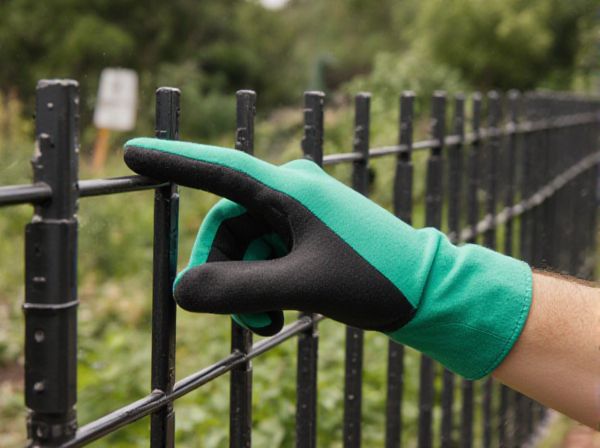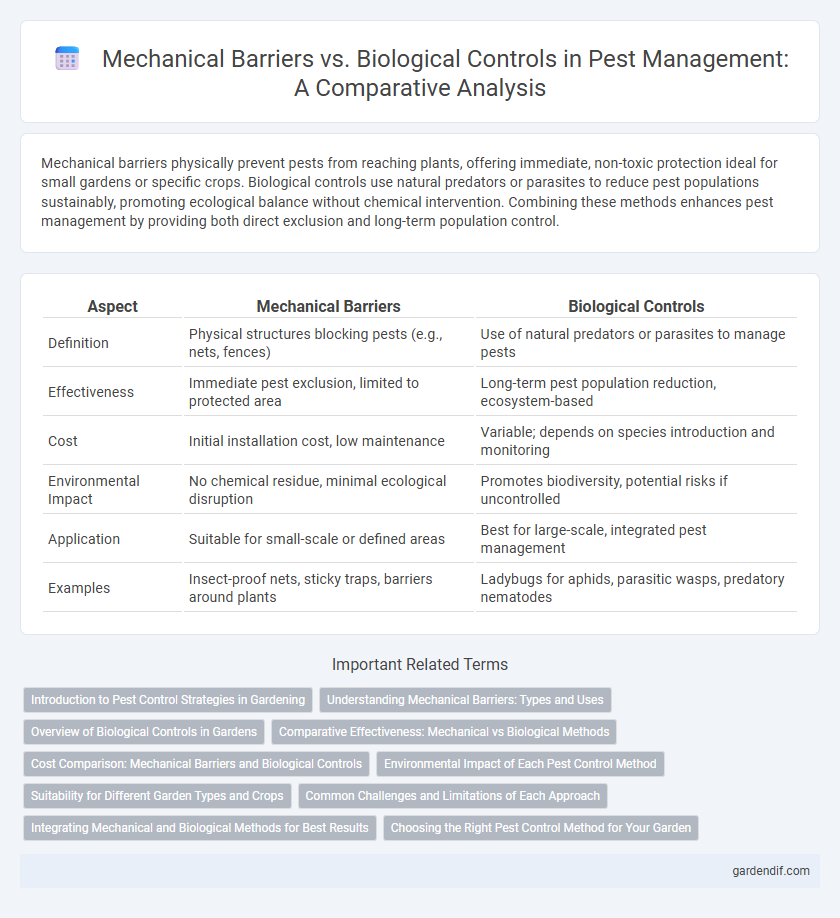
Mechanical barriers vs biological controls Illustration
Mechanical barriers physically prevent pests from reaching plants, offering immediate, non-toxic protection ideal for small gardens or specific crops. Biological controls use natural predators or parasites to reduce pest populations sustainably, promoting ecological balance without chemical intervention. Combining these methods enhances pest management by providing both direct exclusion and long-term population control.
Table of Comparison
| Aspect | Mechanical Barriers | Biological Controls |
|---|---|---|
| Definition | Physical structures blocking pests (e.g., nets, fences) | Use of natural predators or parasites to manage pests |
| Effectiveness | Immediate pest exclusion, limited to protected area | Long-term pest population reduction, ecosystem-based |
| Cost | Initial installation cost, low maintenance | Variable; depends on species introduction and monitoring |
| Environmental Impact | No chemical residue, minimal ecological disruption | Promotes biodiversity, potential risks if uncontrolled |
| Application | Suitable for small-scale or defined areas | Best for large-scale, integrated pest management |
| Examples | Insect-proof nets, sticky traps, barriers around plants | Ladybugs for aphids, parasitic wasps, predatory nematodes |
Introduction to Pest Control Strategies in Gardening
Mechanical barriers such as row covers, sticky traps, and physical screens effectively prevent pest access to plants by creating a physical separation, reducing the need for chemical intervention. Biological controls leverage natural predators, parasites, or pathogens to suppress pest populations, promoting an eco-friendly balance in the garden ecosystem. Integrating mechanical barriers with biological controls offers a sustainable pest management approach, minimizing environmental impact while protecting plant health.
Understanding Mechanical Barriers: Types and Uses
Mechanical barriers effectively prevent pest entry by creating physical obstructions such as screens, nets, row covers, and trunk guards, tailored to specific crops and pests. These barriers reduce reliance on chemical pesticides by blocking insects like aphids, caterpillars, and beetles, thus promoting sustainable pest management. Proper installation and maintenance of mechanical barriers improve crop health and yield by minimizing pest damage without disrupting beneficial insect populations.
Overview of Biological Controls in Gardens
Biological controls in gardens utilize natural predators, parasites, or pathogens to suppress pest populations, promoting ecological balance without harmful chemicals. Common examples include ladybugs targeting aphids, nematodes controlling soil-borne pests, and Bacillus thuringiensis bacteria used against caterpillars. This method enhances long-term pest management by fostering beneficial organisms and reducing reliance on mechanical barriers or synthetic pesticides.
Comparative Effectiveness: Mechanical vs Biological Methods
Mechanical barriers provide immediate, physical protection by blocking pest access to plants, proving highly effective for localized pest control and reducing chemical use. Biological controls utilize natural predators or pathogens to suppress pest populations, offering sustainable and long-term pest management with minimal environmental impact. Comparative studies show mechanical barriers excel in rapid prevention, while biological methods enhance ecosystem balance and pest resistance management.
Cost Comparison: Mechanical Barriers and Biological Controls
Mechanical barriers typically involve upfront costs for materials like nets, row covers, and fencing, with minimal ongoing expenses, making them a cost-effective choice for small to medium-scale applications. Biological controls, such as releasing beneficial predators or microorganisms, often require continuous investment in monitoring and reapplication, leading to higher long-term costs. Evaluating cost efficiency depends on pest pressure, crop value, and scale, where mechanical barriers excel in durability and immediate protection, while biological controls offer sustainable, ecological pest management despite variable expenses.
Environmental Impact of Each Pest Control Method
Mechanical barriers provide a physical defense against pests without introducing chemicals, resulting in zero environmental contamination and preserving non-target species. Biological controls use natural predators or parasites, promoting ecosystem balance but requiring careful species selection to avoid unintended ecological disruption. Both methods reduce pesticide reliance, yet mechanical barriers eliminate chemical risks while biological controls offer sustainable pest suppression through biodiversity.
Suitability for Different Garden Types and Crops
Mechanical barriers offer effective protection for small-scale gardens and high-value crops by physically preventing pest access, especially in fruit orchards and vegetable beds. Biological controls are more adaptable for larger or organic gardens, promoting natural pest regulation through predator release or microbial agents in diverse crop systems. Gardeners should assess crop sensitivity, pest pressure, and garden size when choosing between barrier installation or biological pest management strategies.
Common Challenges and Limitations of Each Approach
Mechanical barriers often face challenges such as high installation and maintenance costs, limited effectiveness against small or flying pests, and physical deterioration over time. Biological controls may be limited by the difficulty of establishing and maintaining viable populations of natural predators, risks of unintended ecological impacts, and slower pest suppression rates compared to conventional methods. Both approaches require careful integration with other pest management strategies to overcome their respective limitations and achieve sustainable pest control.
Integrating Mechanical and Biological Methods for Best Results
Integrating mechanical barriers with biological controls creates a robust pest management strategy by combining physical exclusion and natural predator support. Mechanical barriers such as screens and traps help reduce pest access, while introducing beneficial insects enhances long-term control through ecological balance. This synergy minimizes chemical pesticide reliance, promoting sustainable agriculture and improved crop health.
Choosing the Right Pest Control Method for Your Garden
Mechanical barriers, such as row covers and copper tape, provide immediate and chemical-free protection against pests by physically blocking access to plants. Biological controls utilize natural predators or beneficial insects like ladybugs and nematodes to reduce pest populations sustainably. Selecting the right method depends on factors including the type of pest, garden size, and environmental impact, with many gardeners integrating both strategies for effective and eco-friendly pest management.
Mechanical barriers vs biological controls Infographic

 gardendif.com
gardendif.com